
Finding Solutions
August 13, 2012
By
Andrew Macklin
FOR anyone attending World Bioenergy 2012 in Jönköping, Sweden, it was clear that Canada has become a market of interest for investment and innovation in the biomass industry.
FOR anyone attending World Bioenergy 2012 in Jönköping, Sweden, it was clear that Canada has become a market of interest for investment and innovation in the biomass industry. Canada represented one of the largest international groups of pre-registered delegates, with a wide array of business leaders, innovators, researchers, and project coordinators representing the national interest in the bioenergy marketplace.
With an abundance of valuable information for the Canadian and North American bioenergy industry through a mixture of site visits, educational sessions, networking opportunities and B2B discussions, the conference lived up to its billing as the premier international bioenergy showcase.
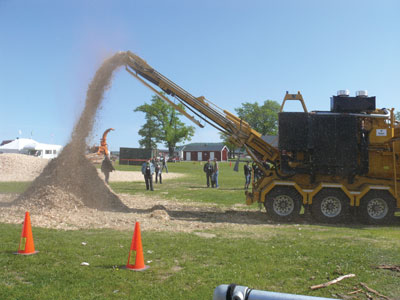 |
|
| Vermeer was one of the few companies that held outdoor demonstrations of chipping equipment at World Bioenergy.
|
Conference Tours
One of the most notable parts of World Bioenergy 2012 was the variety of conference tours that provided opportunities to see CHP, wood pellets, biogas and waste-to-energy solutions that are providing clean energy for the people of Sweden. The sites visited were a glimpse at some of the solutions that could soon enter the Canadian landscape based on size, volume, available resources and cost.
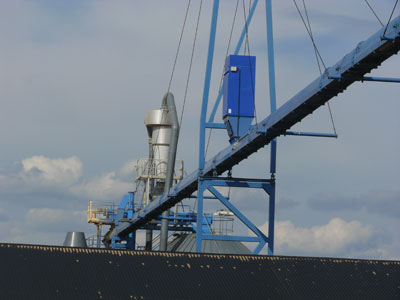 |
|
| A large conveyor system takes chips and sawdust from the Derome sawmill to the Derome pellet mill.
|
The Öresunds Kraft facility in Helsingborg, on the southwest coast of Sweden, has been producing electricity plus district heating and cooling for over 150 years. In 1997, the plant began to introduce wood pellets as an alternative fuel, and by 2006, the plant moved to 100% pellets to fuel its boilers. The boilers run on wood powder, with 200,000 tonnes of pellets being ground at their facility per year.
Using pellets, the plant produces 1,200 GW of power each year for the eighth largest municipality in Sweden. Ten years ago, a large portion of those pellets were imported from the United States. However, a growing pellet industry in Europe has changed Kraft’s purchasing patterns, with only 30% of its pellets now coming from North America. The other 70% are imported from a variety of European markets, all of which arrives at the quay that it owns as part of its operation. No local pellet options are available, with the closest pellet provider nearly 300 kilometres away.
Those shipping lanes were of great interest to many of the Canadians, as affordable transportation of pellet products is a major concern when considering potential supply demands in heavily populated markets like southern Ontario. That combined with the cost of pellets, which Operations Manager Fredrik Joelsson commented was around €120-130 per ton (C$155-$175), are helping to determine the financial feasibility of a similar scale plant in some Canadian cities.
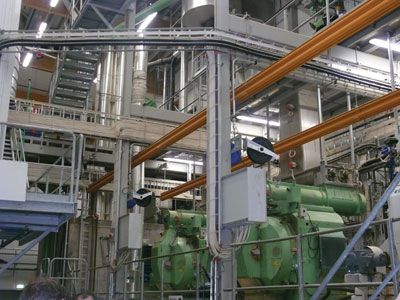 |
|
| Inside the Derome pellet mill. |
At the hem CHP plant in Halmstad known as Oceanen, approximately 80 kilometres north of Helsingborg along the west coast of Sweden, the recent addition of a second wood boiler is helping to offset the increased heat demands that are not met by a nearby plant using biomass. The newest boiler, which has a 22-ton-per-hour capacity, provides 17.5 MW of heat. Three additional boilers use primarily natural gas with some oil as fuel, as well as provide electricity and district heating and cooling in concert with the two wood boilers. In total, Oceanen is able to produce 130 MW of heat energy and 3.2 MW of electricity. Some of that electricity is sold to market, which earns the company green energy certificates.
At Kinnared, in the southern interior of Sweden, the Derome family-owned pellet production plant integrates an on-site sawmill with its facility. Whole trees, 95% of which are spruce, are debarked, chipped and planed, and the chips are then sent across a system of conveyors before arriving at the pellet processing facility. Heat recycled from the sawmill’s boiler is used to dry the chips, which are then combined with shavings and sawdust to create pellets. The hammermills are run off a boiler system that primarily uses the tree bark as fuel. The pellets are then stored in a silo for two weeks to create a higher quality and denser product, and then made available for sale. The company produces over 50,000 tonnes of pellets per year, with 70% bagged for household use and 30% sold in bulk.
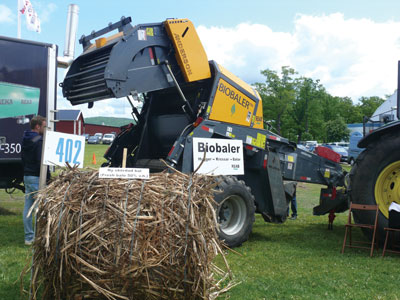 |
|
| The BioBaler, produced by Quebec’s Anderson Group, was one of the Canadian innovations on display at World Bioenergy. |
At the Lantmännen Agroenergi district heating plant in Ödeshög, located on the eastern shore of Lake Vättern, a small CHP plant has eliminated the dependence on fossil fuels for this tiny community. The plant, which has a 3.5-MW wood boiler with a 3-MW oil boiler backup, uses 20,000 cubic metres of wood chips each year to supply homes and businesses with heat across a six-kilometre pipeline. That’s 12.5 GW of heat production annually from a small-scale plant that cost approximately $3 million Canadian to build back in 2001.
Similar to the plant in Ödeshög is the district heating plant in Trosa near Sweden’s east coast. Possessing a 6-MW wood boiler with oil boiler backup, the plant provides heat for 4-5,000 homes and businesses at a cost of around €$6 million (approximately C$8 million) for the facility. The plant was installed by JernForsen, a Swedish company that has developed district heating systems that are meant to be simple across all elements of the operation. As a result, only two full-time staff are manning the plant at any given time.
The plants at both Ödeshög and Trossa are meant to be user-friendly, making it simple for workers to transition from fossil-fuel based energy to biomass. Throughout the tour of both plants, representatives from several countries that have small towns in remote areas with dense wood supply expressed significant interest in pursuing these ideas further as potential solutions for their energy needs.
Providing Tools for Business
There is a reason why over 50 countries were represented at World Bioenergy 2012. Walking the floor of the trade show, listening to the experts in the plenary sessions and speaking to people at B2B socials, it was evident that all of the people had one thing in common: the need for a solution.
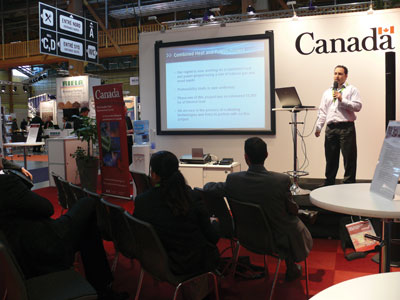 |
|
| Jason Naccarato of the Sault Ste. Marie Innovation Project was one of the presenters at the Canada booth, organized by Canada’s Trade Commissioner Service.
|
For attendees needing to enhance their knowledge of specific elements of the bioenergy business, the plenary sessions did not disappoint. There were five parallel conferences that were offered, targeting current issues affecting the industry: the global pellet market, overall market outlook, energy systems, transportation and biorefining. Each featured informative lectures and discussions from experts around the world, giving attendees a real understanding of the status of the industry in leading, developing and dormant markets.
One of the side events that provided valuable insight into the development of the biomass industry was the poster exhibition. With presentations from leading research institutions around the world, the poster exhibition educated attendees on the innovations in research and development that are driving bioenergy initiatives forward.
Of particular interest was a presentation done by Olga Petrov, a PhD student at the University of British Columbia, on district energy system initiatives and applications in B.C. Petrov is researching the feasibility of three distinct bioenergy initiatives in the province. This research should provide hard data that can be used when speaking with government officials at all levels about the viability of bioenergy solutions in communities across Canada. Petrov hopes to present her research at World Bioenergy 2014.
Not only did the conference tours provide opportunity to make valuable contacts from other countries, but the official dinner, icebreaker reception and business-to-business matchmaking services provided both casual and formal settings to help each attendee meet the person, organization or business who could help provide the business solution needed.
The Canadian Embassy in Sweden provided an extra B2B networking opportunity, hosted by Canada’s Ambassador to Sweden, Kenneth Macartney. The session provided an opportunity for Canadian attendees to meet and discuss bioenergy opportunities with senior business interests from other countries. With the support of additional Canadian dignitaries from other embassies across Europe, delegates were introduced to valuable international contacts to help drive national business interests forward.
The Canadian Presence
The presence of the Canadian government extended well beyond the networking reception. In fact, the work of the Government of Canada’s Trade Commissioner Service helped create some of the best buzz on the trade show floor. The service helped organize the Canada Speaker’s Corner, featuring daily presentations based on national capabilities, innovations and investment opportunities in bioenergy.
There was great interest shown by international delegates in the research and development being done in the bioenergy industry in Canada. Mark Ryans, the research manager for FPInnovations, spoke about the number of facilities across Canada that are conducting leading international research on products like nanocrystalline cellulose (NCC). That discussion also included talk of the pilot lignin precipitation facilities located at the Bioeconomy Centre in Thunder Bay.
Promotion of Canada’s emerging bioenergy innovations was also at the heart of a presentation from Rolf Fyne, the director of business development Europe, trade and invest British Columbia. Fyne talked to the crowd of international delegates about the 1,300 clean tech companies that currently operate in the province, which is also home to 24 clean tech research centres and institutions. He also made special mention of companies in British Columbia doing innovative work gaining international attention, for example, Nexterra, Dynamotive, Lignol and Altentech Power Inc.
Opportunities for Investment
Fyne also pushed British Columbia as an optimal location for foreign investment in the bioenergy industry, as it is one of the only Canadian provinces that had international trade representatives promoting opportunities in the expanding market.
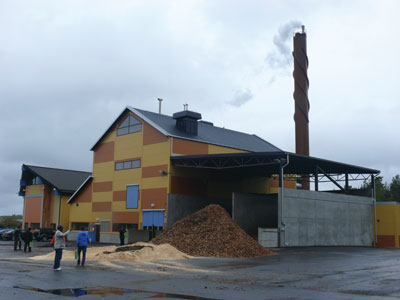 |
|
| An exterior look at the district heating plant in Trosa.
|
With 16 million hectares of “red attack” and “grey attack” lands holding unused fibre that needs to be collected, and 54 million hectares of certified wood, there are opportunities in B.C. for removal of the high-quality wood sources through fibre supply agreements. It was stressed that corporate partners are already coming on board, with over 500,000 tonnes of annual pellet production already committed. However, new foreign investments had to happen under the purview of the EURO 20:20:20 agreement according to Fyne.
In addition to the investment opportunity in wood supply and wood sources, British Columbia was touted as an excellent place to invest in small district heating plants for some of the smaller communities spread throughout the province. Stressing the high cost of B.C. Hydro’s import of diesel fuels for power generation, district heating using woody biomass was pitched as a sound investment.
For Ontario, advantages offered through the province’s feed-in tariff system provide excellent opportunities for foreign investment in bioenergy according to Angela Spreng, commercial officer with the Ontario International Marketing Centre in Munich, Germany. She pointed to two projects in development that show the strength of the investment opportunities that the province possesses: the Olympiad Renewable Energy Centre in White River and the conversion of the Atikokan coal plant to pellets and biofuel.
Quebec’s bioenergy sector continues to see solid growth through innovation according to France Bourdon, the director of business development Europe, at Investissement Québec. One of the projects showcasing growth is the NCC Celluforce plant developed in Windsor through a partnership between FPInnovations and Domtar.
Members of the corporate bioenergy community in Québec who had come to World Bioenergy looking to expand their business interests also spoke to opportunities for foreign investment. For example, Airex Energi of Drummondville plans to break ground later this year on a torrefaction demonstration plant. With an estimated capacity of two tonnes per hour, the plant will be a stepping-stone towards a larger plant by the end of 2013. Also looking for investment in the pellet production industry was Atlantic Fibre Resources, which has plans to expand its facility in Chandler to support production of 250,000 tonnes of pellets per year. Both companies spoke about the strategic value of investing in the Quebec bioenergy industry, a province that has both the resources and innovation to sustain industry growth.
Promoting Canadian Products
Atlantic Fibre Resources was one of three Canadian companies that had a booth on the trade show floor in an attempt to increase its business.
The Anderson Group of Chesterville, Quebec, is the company behind the BioBaler. One of the few companies to have its equipment as part of the outdoor demonstration area, the company pushes the product as a solution to clean up wood residue, vegetation and invasive plant species and turn it into bales for use as a fuel source. The units have already sold on three continents, and company president Patrice Desrochers came with his team to World Bioenergy looking to expand its current clientele.
The other Canadian company on the show floor was Vancouver-based InterWrap Papers Ltd., the manufacturer of BioBlanket, which covers wood products in the forest before collection, helping to dry the product and prevent additional moisture from getting to the wood. With the majority of its customer base in Finland and Sweden, the company took World Bioenergy as an opportunity to both meet with current customers and look for additional customers.
Looking Ahead to WBE 2014
As the global push for the development of sustainable energy continues to grow in both developed and Third World countries, the resources and expertise presented at World Bioenergy will become even more valuable to the international community.
With Canada being one of the most prominent areas of potential growth in the bioenergy industry, World Bioenergy will continue to be one of the best places to gain knowledge, expertise, and business connections that will help drive business forward.
Print this page